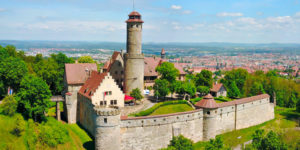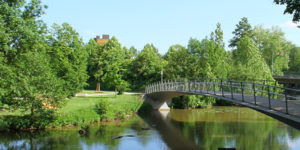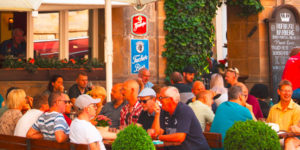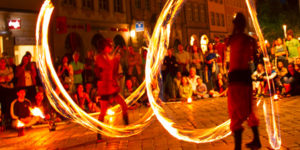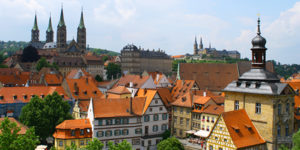Bamberger Reiter (Bamberg Horseman)
One of Bamberg's most famous landmarks is the Bamberg Reiter (Bamberg Horseman). He can be found in the cathedral on the north pillar of the Georgen Choir. It represents a life-size statue made of reed sandstone, whose identity could not be completely clarified until today. For this reason, a number of historians and scientists have been working for years on further researching the background of the equestrian statue.
Historical background
It was possible to prove that the sculpture must have been created in the first half of the 13th century. Its origin overlaps with the construction of the new Bamberg Cathedral and dates back to the time of Ekbert of Andechs-Meranien, who was bishop of the diocese of Bamberg at the beginning of the 13th century. A severe blow struck the House of Andechs-Meranien on 21.6.1208: King Philipp was murdered in Ekbert's residence in Bamberg by Palatine Count Otto von Wittelsbach. The noble family of the Andechs meranians was extremely influential, especially in southern Bavaria and Franconia in the 11th to 13th centuries. The investigations of the Bamberger Reiter revealed that it had always stood on the same site since it was first built, was made between 1225 and 1237 and has therefore always been part of the Bamberger Cathedral's inventory.
Research and interpretation
The creator of the work of art is also unknown but there is no doubt that two different art schools were commissioned to furnish the cathedral. The first was responsible for the reliefs and ornaments, the second for the sculptures, which also included the Bamberger Reiter.
Only after the discovery in 2004 that the figure was still standing in the same place as when it was erected was it possible to begin further investigations. The rider's horse stands parallel to the north pillar, almost in resting position. Only the left hind leg is raised, so that when looking at it one gets the impression that the horse has just come to a standstill. The rider himself looks to the right, is not armed himself, is wrapped in an elaborate robe and wears a royal crown. A canopy also rises above his head.
His view to the right shows the old imperial tomb of Heinrich II and Kunigunde, who were buried in the former Heinrichsdom. However, since the present cathedral is larger and has a different floor plan, the grave had to be relocated. And exactly at this place the rider seems to look. At the same time his gaze is directed at the Fürstenportal, from which it can be concluded that he symbolically enters the gate and pauses to pay homage to the imperial tomb.
While today the horseman stands almost bare on his pedestal, investigations have discovered colour particles on the surface which prove that he must have been painted once. The pedestal was green, the horse white, the robe red with golden decorations and the crown dyed in gold.
As the oldest surviving equestrian statue of the Middle Ages, the statue attained doubtful fame during the National Socialist era. He is said to have been of Aryan descent, once had straw blond hair and also adorned the 100 Mark Reichsbank note. Research proved the opposite, as remains of colour show that the rider had black hair.
Theories and explanations
Despite intensive research, the identity of the rider remains unsolved to this day. Assumptions that it could be Henry II can be refuted beyond doubt, since the aforementioned person wears a royal crown.
Since he is unarmed, it is assumed that the statue shows Saint Stephen. He was King of Hungary and also a brother-in-law of Emperor Henry II. According to legend, King Stephan visited Bamberg when he was still unbaptized. It is said that he rode his horse into St. Henry's Cathedral to convert to Christianity. After his death Stephan was buried in Bamberg Cathedral. According to the current state of affairs, this is considered to be the most plausible of all theories.
Another attempt at explanation, which is often discussed among experts, revolves around the Swabian King Philip, who was about to be elected emperor. He had come to Bamberg to take part in the wedding of his niece Beatrix of Burgundy and was murdered in his chambers on 21 June 1208 by Count Palatine Otto VIII von Wittelsbach. Philip was temporarily buried in Bamberg Cathedral, but was transferred to Speyer in 1214 by his nephew Frederick II. Whether and to what extent, there is a connection with the equestrian statue is controversial.
It is also conceivable that the horseman does not represent a real person, but symbolizes the Staufer family. Like Philip von Schwaben, the youngest son of Friedrich I. Barbarossa, King Konrad III, who was buried in the cathedral on 15 February 1152, came from the House of the Staufers, who had a great influence on the city until the 14th century. The Crusades, led by Frederick II of the Staufer dynasty, also took place during the Cathedral's construction.
Hint: Unnoticed by many tourists, there is a stele on the green area in front of the canons' courts, 200 metres above the cathedral square, which was built in 2015 in honour of the Staufer dynasty and on the occasion of the 750th anniversary of the death of the last Staufer emperor Friedrich II in the year 2000.
Address
- Domplatz, 96049 Bamberg

